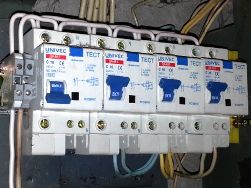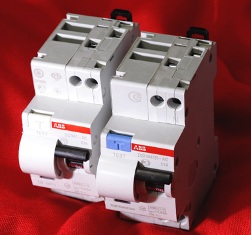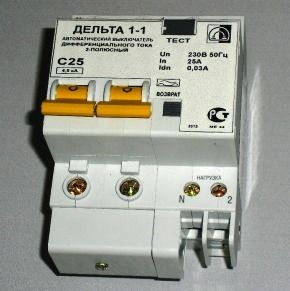Categories: Electrician at home, Automata and RCD
Number of views: 151,355
Comments on the article: 17
How to choose a differential machine
 Before talking about the choice of a differential automaton, it should be explained how this issue has earned such popularity. Why are differential automata good? Of course, by the fact that the difavtomat is a device that provides the line not only protection against overload currents and overcurrents of short circuit, but also protection against leakage currents, that is, protection against electric shock from a person.
Before talking about the choice of a differential automaton, it should be explained how this issue has earned such popularity. Why are differential automata good? Of course, by the fact that the difavtomat is a device that provides the line not only protection against overload currents and overcurrents of short circuit, but also protection against leakage currents, that is, protection against electric shock from a person.
In other words, a single device provides the full range of necessary protections. This is very convenient because it saves space in the distribution board and simplifies installation. In some cases, money savings are also achieved, but this is relative, since a high-quality differential machine can be more expensive than a single machine residual current device (RCD).
So, what is good for difavtomat, clearly. It remains to decide how to choose it.
1. Phase
Like any other protection device, the difavtomat should be selected based on the phase of the network. Three-phase differs have three poles for connecting the phases and one pole for the neutral working conductor. For obvious reasons, the three-phase differential differs in large dimensions and occupies six to seven modules. Single-phase diffs can occupy two to four modules, depending on the version. However, in any case, the difavtomat will take up much less space than a conventional machine and RCD combined.
2. Rated voltage
Although in the general case it can be difficult to miss: three phases - 380 volts, and one phase - 220 volts. But still, there are rare unpleasant exceptions, and you should pay attention to the nominal voltage of the device.
3. The characteristics of the releases and the rating of the machine
Since the differential is too circuit breaker, then of course he also has characterizationdisplayed by the letter of the Latin alphabet in front of a number representing the nominal value of the current load. As for household networks, here traditionally the most popular are the automatic machines of characteristic C.
For example, for a socket network, a difavtomat of characteristic C16 (less often C25) is suitable. For lighting networks, C6 or C10 machines are used. More rarely, automatic machines of characteristic B are used. Automatic C50, C63, C80 and C100 machines are often used as input common house or apartment switches.

4. Leakage current rating
This is a characteristic of the residual current circuit breaker included in the difavtomat. Nominal leakage current indicated by the symbol "delta" and a number indicating the actual leakage current with the letters mA (milliamps). To protect the outlet and lighting networks, diffuses with a rating of 10-30 mA are usually used. Most often, group networks are protected by 30 mA devices, and single sockets by 10 mA. The introductory difiltomat can have a built-in RCD of 100-300 mA.
5. Type or class of embedded RCD
It has long been known that there are RCDs of type AC that respond only to a sinusoidal (alternating) leakage current, and there are RCDs of type A that respond to DC leakage in devices with electronic converters. All this applies to RCDs built into difavtomaty. Thus, for lines supplying computers, televisions, and even washing machines, it is advisable to use difavtomats with built-in RCDs of type A, since the type of speaker can simply turn out to be ineffective.
6. The presence / absence of protection against a break in the neutral conductor
This is a very curious moment. The fact is that for the operation of the built-in RCD, it is necessary to power the differential protection unit. This power is taken from the input of the device. That is, in order for the differential protection of the difavtomat to work, it is necessary that there is voltage in the network.
This means that both zero and phase working conductors must be in order.Moreover, if there is no “phase" - then God is with him, because the leakage current is nowhere to come from. Another thing is if zero is cut off. Then the remaining "phase" can cause a leak, and the built-in RCD will no longer work due to lack of power.
To prevent such a phenomenon, some difavtomats incorporate a block of protection against the breakage of the neutral conductor, which in essence is a voltage relay, whose contacts operate to open.
If there is no such unit in the differential, then there are all reasons to independently install on the input of the voltage relay to control the situation.
7. Difavtomat manufacturer
No matter how strong the desire to save, it is better to refrain from acquiring diphs of dubious origin. There are well-known cases of the appearance of cheap automatic machines on the market, which upon closer examination were not even automatic machines: they did not have any releases, except for mechanical manual ones.
It is completely logical that there is the possibility of acquiring a difavtomat of a similar design. But a differential is an apparatus whose functions are often not duplicated in any way. That is, the safety of the power grid as a whole remains on the conscience of the dif. And he simply must be of high quality. We will not give specific instructions on brands and brands, but it is better to purchase devices in trusted stores and not rush at excessively low prices.
8. General instructions
Each difavtomat has a “test” button in its composition, allowing you to check its performance by creating an intentional leakage of current. After installing the device, it will always be worthwhile to carry out a small check using this button.
In addition, it should be remembered that not every line must be equipped with differential protection. Most often, diflavomats are placed on cable lines of sockets, as well as on the common input for fire fighting purposes. The lighting and power lines of an electric range are often not equipped with differential protection.
Not that it could be taken as a guide not to put difavtomats on these lines. But you can take into account, for example, in the absence of sufficient space in the switchboard, use simple circuit breakers for the lighting network and the cable line of the electric stove.
Difavtomats, as well as RCDs, are recommended for installation in networks that include a protective neutral PE conductor. This is an PUE requirement. In the absence of protective grounding, the protection itself from leakage currents may not be effective enough and not save a person from electric shock.
Difavtomats and RCDs are important not only to choose correctly, but also to connect without errors. How to do this correctly is described in this article:Schemes for connecting RCDs and differential machines. Follow the publications on our website!
See also at e.imadeself.com
:

